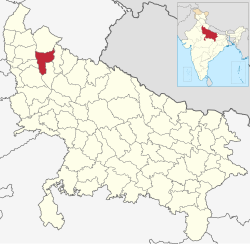Amroha district
Amroha district | |
|---|---|
 Location of Amroha district in Uttar Pradesh | |
| Country | India |
| State | Uttar Pradesh |
| Division | Moradabad |
| Headquarters | Amroha |
| Government | |
| • Lok Sabha constituencies | Amroha |
| Area | |
| • Total | 2,321 km2 (896 sq mi) |
| Population (2011) | |
| • Total | 1,840,221 |
| • Density | 790/km2 (2,100/sq mi) |
| • Urban | 56% |
| Demographics | |
| • Literacy | 50.21 per cent[1] |
| Time zone | UTC+05:30 (IST) |
| Average annual precipitation | 1,120 mm |
| Website | https://amroha.nic.in/ |
Amroha district is one of the 75 districts of Uttar Pradesh state in northern India.[2] Amroha town is the district headquarters. According to the Government of India, the district is one of the Minority Concentrated Districts on the basis of the 2001 census data on population, socio-economic indicators and basic amenities indicators.[3]
The district is bounded on the north by Bijnor District, on the east and southeast by Moradabad District, on the south by Badaun District, and on the west by the River Ganges, across which lie the Bulandshahr, Hapur, and Meerut districts. State Highways 72 and 73 penetrate the city and act as major routes.
History[edit | edit source]
The Battle of Amroha was fought between the Mongols and Alauddin Khilji on 20 December 1305. Alauddin won the battle. Later, the territory occupied by the present district was part of the Sambhal sarkar of Delhi subah under the Mughal empire. Later it came under the control of Awadh. In 1801, the administration of this territory was ceded to the British East India Company by the Nawab of Awadh. On 24 April 1997, this district was carved out by separating Amroha, Dhanora and Hasanpur tehsils of the erstwhile Moradabad district. In 2012, this district was renamed from Jyotiba Phule Nagar district to Amroha district.[2] Amroha has produced many gems in varied find of sports, education, engineering, business, technology, industries and lot more.
Famous personalities[edit | edit source]
- Ahmad Hasan Amrohi, Islamic scholar and jurist
- Kamal Amrohi, filmmaker, lyricist, actor, director, husband of Meena Kumari
- Jaun Elia, poet and columnist
- Mohammad Shami, cricketer
- Syed Sadequain Ahmed Naqvi, artist
- Dr Naseem uz Zafar Baquiri, poet, lyricist, doctor
- Iqbal Mehdi, artist
- Nawab Waqar ul Mulk, educationalist, politician
- K.A. Nizami, historian
- Nisar Ahmed Faruqi, Education
- Niranjan Singh, Scientist ISRO
- Khushboo Mirza, Scientist ISRO
Demographics[edit | edit source]
According to the 2011 census 'Amroha District' has a population of 1,840,221,[5] roughly equal to the nation of Kosovo[6] or the US state of Nebraska.[7] This gives it a ranking of 258th in India (out of a total of 640).[5] The district has a population density of 818 inhabitants per square kilometre (2,120/sq mi).[5] Its population growth rate over the decade 2001-2011 was 22.66%.[5] Amroha has a sex ratio of 907 females for every 1,000 males,[5] and a literacy rate of 65.7%.[5]
At the time of the 2011 Census of India, 80.10% of the population of the district spoke Hindi and 19.70% Urdu as their first language.[8]
| Year | Pop. | ±% p.a. |
|---|---|---|
| 1901 | 328,739 | — |
| 1911 | 348,293 | +0.58% |
| 1921 | 330,488 | −0.52% |
| 1931 | 354,024 | +0.69% |
| 1941 | 406,143 | +1.38% |
| 1951 | 457,922 | +1.21% |
| 1961 | 550,228 | +1.85% |
| 1971 | 681,551 | +2.16% |
| 1981 | 891,539 | +2.72% |
| 1991 | 1,155,742 | +2.63% |
| 2001 | 1,499,068 | +2.64% |
| 2011 | 1,840,221 | +2.07% |
| source:[9] | ||
Media[edit | edit source]
Amroha has several active media groups which continuously give the populace Hindi news updates on Amroha:
- Amar Ujala[10]
- Dainik Bhaskar
- Dainik Jagran
- Awam-e-hind
- Amroha ki Ekta(Hindi Weekly newspaper)
References[edit | edit source]
- ↑ "District-specific Literates and Literacy Rates, 2001". Registrar General, India, Ministry of Home Affairs. Retrieved 10 October 2010.
- ↑ 2.0 2.1 "Important Cabinet Decisions". Lucknow: Information and Public Relations Department. Retrieved 17 January 2013.
- ↑ "Press Information Bureau English Releases". Pib.nic.in. Retrieved 13 June 2012.
- ↑ "Amroha Religion Census 2011". Office of the Registrar General and Census Commissioner, India. Retrieved 16 November 2015.
- ↑ 5.0 5.1 5.2 5.3 5.4 5.5 "District Census 2011". Census2011.co.in. 2011. Retrieved 30 September 2011.
- ↑ US Directorate of Intelligence. "Country Comparison:Population". Retrieved 1 October 2011.
Kosovo 1,825,632 July 2011 est.
- ↑ "2010 Resident Population Data". U. S. Census Bureau. Archived from the original on 19 October 2013. Retrieved 30 September 2011.
Nebraska 1,826,341
- ↑ 2011 Census of India, Population By Mother Tongue
- ↑ Decadal Variation In Population Since 1901
- ↑ "Hindi Newspapers". Amar Ujala. Retrieved 13 July 2016.
External links[edit | edit source]
Template:Districts of Uttar Pradesh Template:Minority Concentrated Districts in India
Coordinates: 28°54′00″N 78°28′12″E / 28.90000°N 78.47000°E
Rickard, J (7 April 2010), Battle of Amroha, 20 December 1305, historyofwar.org